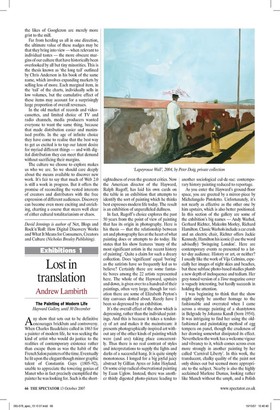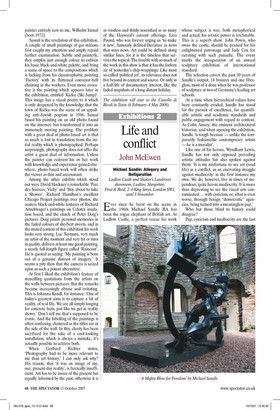Lost in translation
Andrew Lambirth The Painting of Modern Life Hayward Gallery, until 30 December Any show that sets out to be definitive encourages brickbats and controversy. When Charles Baudelaire called in 1863 for a painter of modern life, he was seeking the kind of artist who would do justice to the realities of contemporary existence rather than escape them as was the habit of the French Salon painters of the time. Eventually he lit upon the elegant though minor graphic talent of Constantin Guys (1805-92), unable to appreciate the towering genius of Manet who in fact precisely exemplified the painter he was looking for. Such is the shortsightedness of even the greatest critics. Now the American director of the Hayward, Ralph Rugoff, has laid his own cards on the table in an exhibition that attempts to identify the sort of painting which he thinks best expresses modern life today. The result is an exhibition of unparalleled dullness.
In fact, Rugoff's choice explores the past 50 years from the point of view of painting that has its origin in photography. Here is his thesis — that the relationship between art and photography lies at the heart of what painting does or attempts to do today. He states that his show features 'many of the most significant artists in the recent history of painting'. Quite a claim for such a dreary collection. Does 'significant' equal 'boring' as the satirists have so frequently led us to believe? Certainly there are some fantastic bores among the 22 artists represented here. The whole of the Hayward, upstairs and down, is given over to a hundred of their paintings, often very large, though for variation there are some of Elizabeth Peyton's tiny canvases dotted about. Rarely have I been so depressed by an exhibition.
It's the overall effect of the show which is depressing, rather than the individual paintings. And this is because it takes a tendency of art and makes it the mainstream: it presents photographically-inspired art without any of the other kinds of painting which were (and are) taking place concurrently. Thus there is no real contrast of styles and interpretations to supply the lights and darks of a successful hang. It is quite simply monotonous. I longed for a big joyful juicy abstract by Gillian Ayres or John Hoyland. Or some crisp radical observational painting by Euan Uglow. Instead, there was another thinly digested photo-picture leading to another sociological cul-de-sac: contemporary history painting reduced to reportage.
As you enter the Hayward's ground-floor space, you are greeted by a mirror-piece by Michelangelo Pistoletto. Unfortunately, it's not nearly as effective as the other one by him upstairs, which is also better positioned. In this section of the gallery are some of the exhibition's big names — Andy Warhol, Gerhard Richter, Malcolm Morley, Richard Hamilton. Classic Warhols include a car crash and an electric chair, Richter offers Jackie Kennedy, Hamilton his iconic (I use the word advisedly) 'Swingeing London'. Here are contemporary events re-presented to a latter-day audience. History or art, or neither? I usually like the work of Vija Celmins, especially her images of night skies and beaches, but these subfusc photo-based studies plumb a new depth of ineloquence and tedium. Her grey-toned version of a Time magazine cover is vaguely interesting, but hardly succeeds in holding the attention.
I was beginning to think that the show might simply be another homage to the fashionable and overrated when I came across a strange painting of a shantytown in Belgrade by Johanna Kandl (born 1954). It was intriguing to find her using the oldfashioned and painstaking method of egg tempera on panel, though the crudeness of her drawing somewhat dissipated its effect. Nevertheless the work has a welcome vigour and vibrancy to it, which comes across even more strongly in another painting by her called 'Carnival Liberty'. In this work, the translucent, chalky quality of the paint not only shines out but seemed more appropriate to the subject. Nearby is also the highly acclaimed Marlene Dumas, looking rather like Munch without the umph, and a Polish painter entirely new to me, Wilhelm Sasnal (born 1972).
Sasnal is the revelation of this exhibition. A couple of small paintings of gas stations first caught my attention and amply repaid further examination. Subtle and painterly, they employ just enough colour to enliven his basic black-and-white palette, and bring a sense of space to the compositions which is lacking from his claustrophobic painting 'Factory' with its flattened conveyor-belt chaining in the workers. Even more evocative is the painting which appears later in the exhibition, entitled 'Kielce (Ski Jump)'. This image has a visual poetry to it which is only deepened by the knowledge that the town of Kielce was the scene of an appalling anti-Jewish pogrom in 1946. Sasnal based his painting on an old photo found on the internet, but transformed it into an immensely moving painting. The problem with a great deal of photo-based art is that so much is lost in translation from the initial reality which is photographed. Perhaps surprisingly, photography does not offer the artist a great deal of information. Unless the painter can reinvest his or her work with knowledge and experience gained elsewhere, photo-based work will often strike the viewer as thin and unresonant.
Among the other exhibits which stood out were David Hockney's remarkable 'Parc des Sources, Vichy' and 'Boy about to take a Shower', Richard Hamilton's excellent Chicago Project paintings over photos, the austere black-and-white textures of Richard Artschwager's paintings on Celotex insulation board, and the clutch of Peter Doig's pictures. Doig paints personal memories in the faded colours of sherbert sweets, and in the muted context of this exhibition his work looks very strong. Luc Tuymans, very much an artist of the moment and very hit or miss in quality, delivers at least one good painting, a nearly full-length figure called 'Raincoat'. He is quoted as saying: 'My painting is born out of a genuine distrust of imagery.' It seems a pity then that the camera is seized upon as such a potent alternative.
At first I liked the exhibition's feature of stencilling quotations from the artists on the walls between pictures. But the remarks became increasingly obtuse and irritating. This is Johanna Kandl, for instance: 'One of today's greatest aims is to capture a bit of reality, of real life. We are all simply longing for concrete facts, just like we get in reality shows.' Don't tell me that's supposed to be ironic. And the labelling of the paintings is often confusing, clustered as the titles are at the side of the wall. In this, clarity has been sacrificed for the sake of a cool-looking installation, which is always a mistake; it's actually possible to achieve both.
When Gerhard Richter states, 'Photography had to be more relevant to me than art history,' I can only ask why? His reason, that 'it was an image of my, our, present-day reality', is farcically insufficient. Art has to be aware of the present but equally informed by the past, otherwise it is as rootless and thinly nourished as so many of the Hayward's current offerings. Ezra Pound, who was forever urging us 'to make it new', famously defined literature as news that stays news. Art could be defined along similar lines, for it is the timeless that survives the topical. The trouble with so much of the work in this show is that it has the forlorn air of yesterday's chip-wrappings. Like most so-called 'political art', its relevance does not live beyond its context and source. Or only in a half-life of documentary interest, like the faded snapshots of a long-distant holiday.




































































 Previous page
Previous page